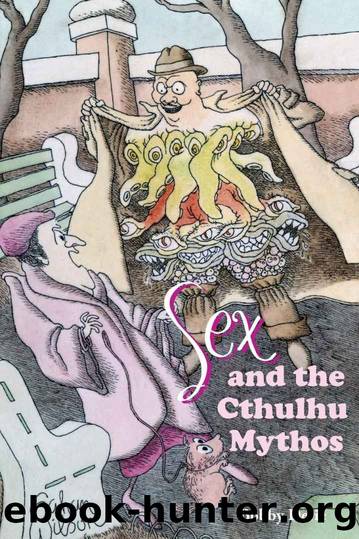Sex and the Cthulhu Mythos by Bobby Derie

Author:Bobby Derie [Derie, Bobby]
Language: eng
Format: azw3, epub
Publisher: Hippocampus Press
Published: 2015-11-18T16:00:00+00:00
Gender, Sexuality, and Mythos Writers
The men and women behind the Mythos are all sexual beings, and in many cases this aspect of their nature is reflected in their Mythos work and worthy of examination. That said, in this chapter I have not made an effort to single out writers based on their sex or gender alone. If any authors are discussed here, it is because I have felt that their work in the Mythos is important and worthy of examination, regardless of their gender or sexuality. Their sex, whatever it may be, is primarily of interest in shedding light on how and why they have written as they have done. To put this in some perspective, a brief examination of sex and gender in terms of Mythos writers may be beneficial.
A scientific study of gender and sexuality among published Mythos writers has not been doneâand would be very difficult, given the relative obscurity of many, and the penchant for pseudonymsâbut a very rough survey of names in Chaosiumâs Call of Cthulhu fiction line tends to support the idea that the vast majority of Mythos authors are male; though if names are anything to go by, the number of female Mythos writers has been steadily increasing over the last several decades, or at least are being published with greater frequency. This is not particularly revelatory given that the Cthulhu Mythos has its beginnings in weird and pulp fiction, which in the United States of the 1920s and â30s was dominated by male writers and editors.
The first female writers associated with the Mythos were Lovecraftâs collaborators in the amateur press such as Anna Helen Crofts, Elizabeth Berkeley (pseudonym of Winifred Virginia Jackson), and Sonia Haft Greene, and female revision clients such as Zealia Reed Bishop and Hazel Heald. Lovecraftâs contemporaries who contributed to the growing Mythos while he was alive and immediately after his death were almost exclusively maleâthe most notable female pulpster of the era associated with Lovecraft is his correspondent C. L. Moore, who collaborated with Lovecraft in âThe Challenge from Beyondâ (1935); her stories such as âShambleauâ may show some influence from the Mythos (and certainly influenced later authors), but she did not participate in the creation of books, entities, people, and places in the manner of Robert E. Howard or Clark Ashton Smith.
Whoever may be considered the âFirst Female Mythos Writer,â women were underrepresentedâbasically unrepresented, in the case of Arkham House anthologies and collectionsâin Mythos fiction for several decades after Lovecraftâs death. This began to change in the 1960s with the advent of writers like Joanna Russ, the continued spread of the Mythos to new generations, and the proliferation of Mythos publications under other publishers. One of the most encouraging developments of recent years is the appearance of female editors of Mythos fiction collections, such as Silvia Moreno-Garcia and Paula Stiles, editors of Historical Lovecraft (2011) and Future Lovecraft (2011), and Carrie Cuinn of Cthulhurotica (2010), along with female Mythos novelists such as Molly Tanzer, who wrote A Pretty Little Mouth (2013).
Download
This site does not store any files on its server. We only index and link to content provided by other sites. Please contact the content providers to delete copyright contents if any and email us, we'll remove relevant links or contents immediately.
Call Me by Your Name by André Aciman(20372)
Ready Player One by Cline Ernest(14524)
How to Be a Bawse: A Guide to Conquering Life by Lilly Singh(7391)
Wiseguy by Nicholas Pileggi(5671)
The Kite Runner by Khaled Hosseini(5083)
On Writing A Memoir of the Craft by Stephen King(4863)
Audition by Ryu Murakami(4850)
The Crown by Robert Lacey(4723)
Call me by your name by Andre Aciman(4619)
Gerald's Game by Stephen King(4582)
Harry Potter and the Cursed Child: The Journey by Harry Potter Theatrical Productions(4440)
Dialogue by Robert McKee(4321)
The Perils of Being Moderately Famous by Soha Ali Khan(4169)
Dynamic Alignment Through Imagery by Eric Franklin(4116)
Apollo 8 by Jeffrey Kluger(3637)
Seriously... I'm Kidding by Ellen DeGeneres(3577)
The Inner Game of Tennis by W. Timothy Gallwey(3575)
How to be Champion: My Autobiography by Sarah Millican(3555)
Darker by E L James(3477)
